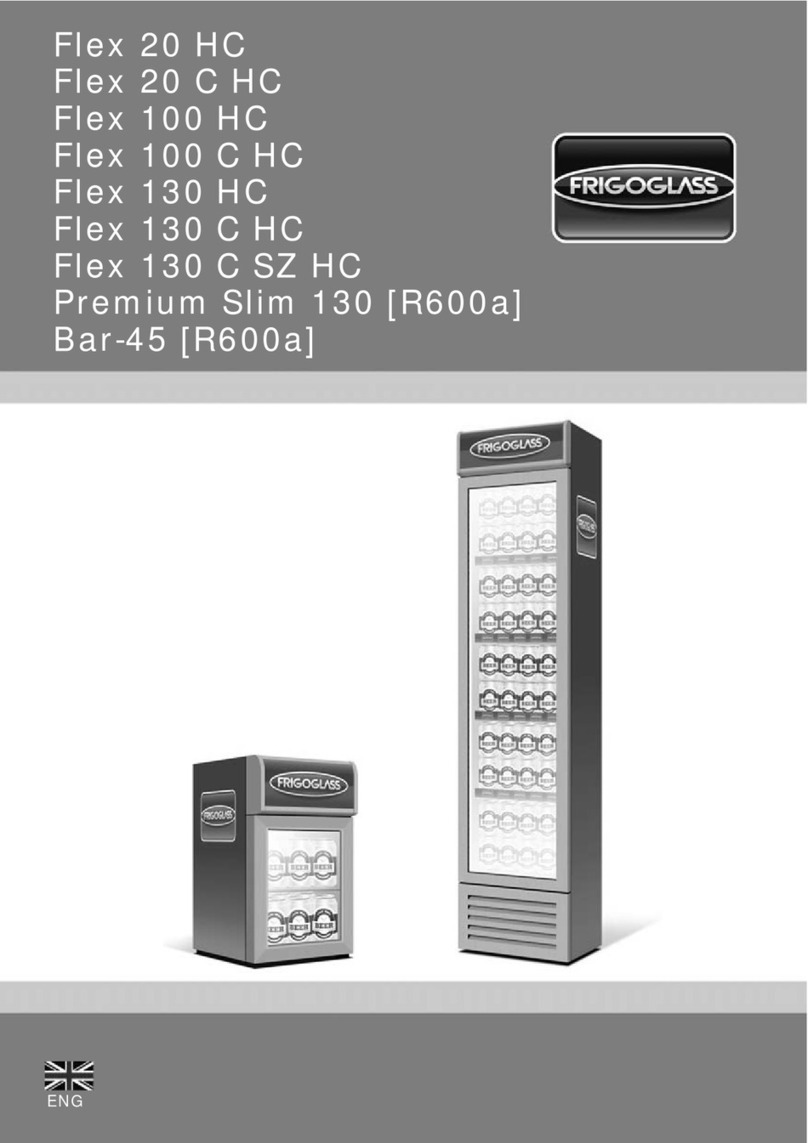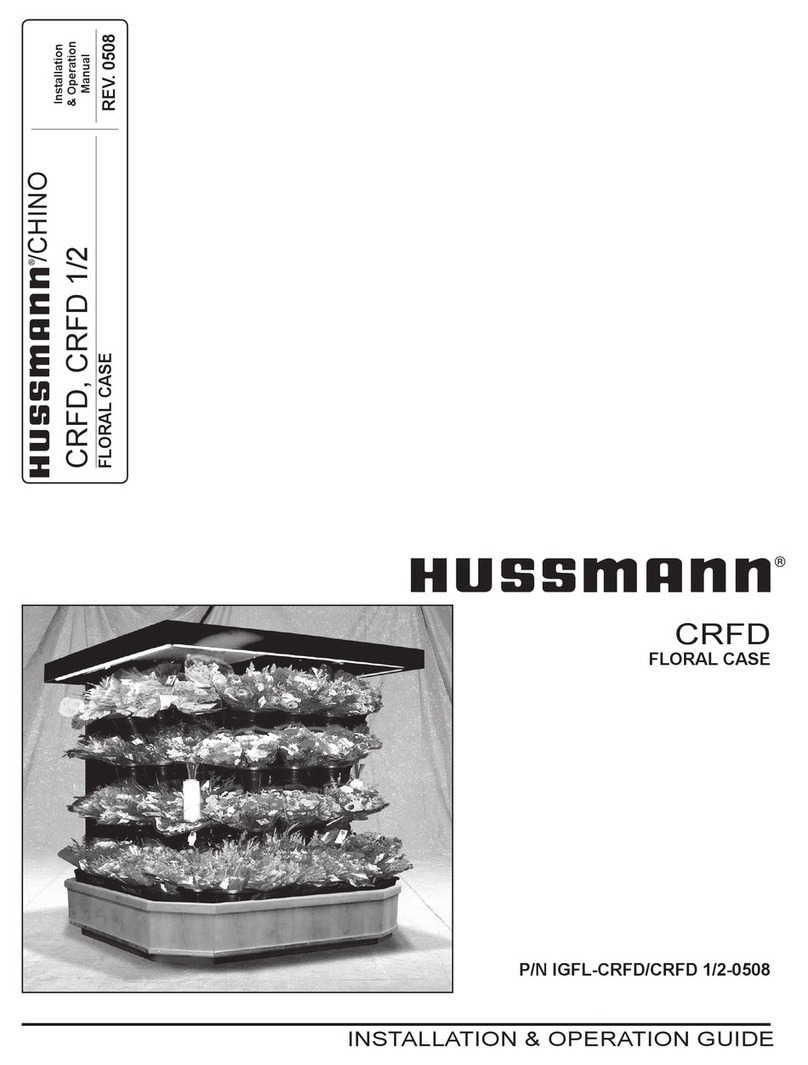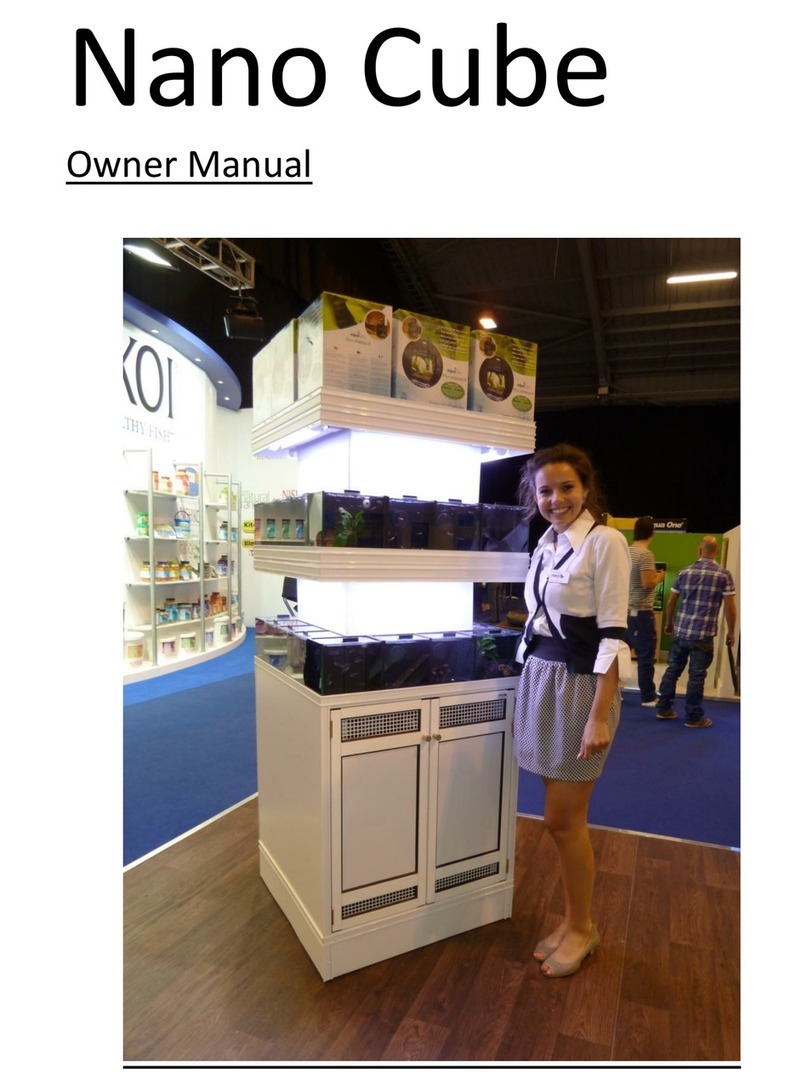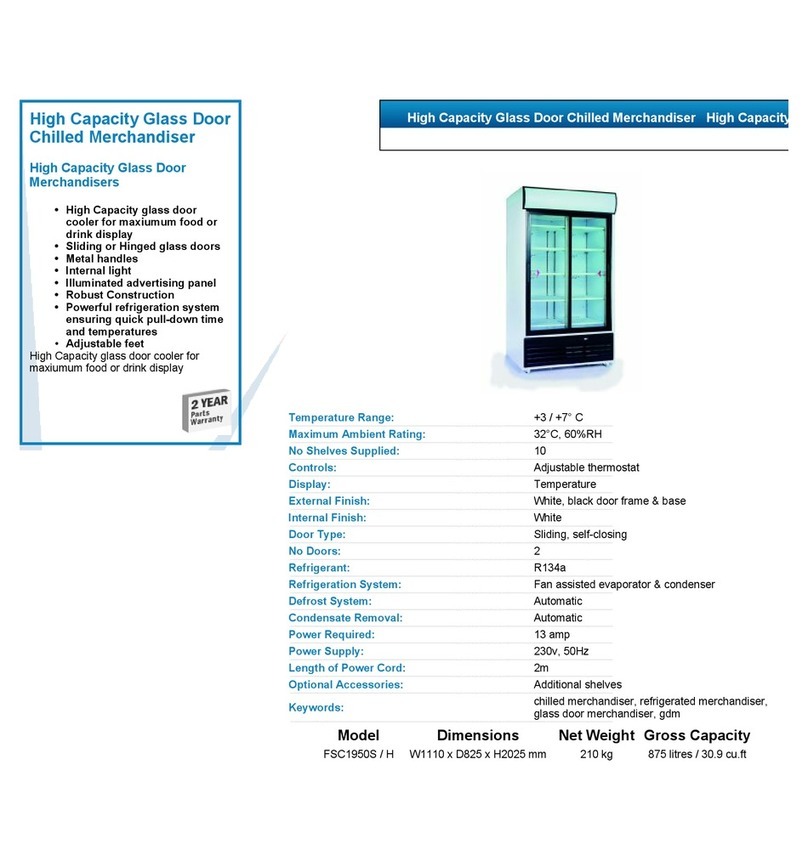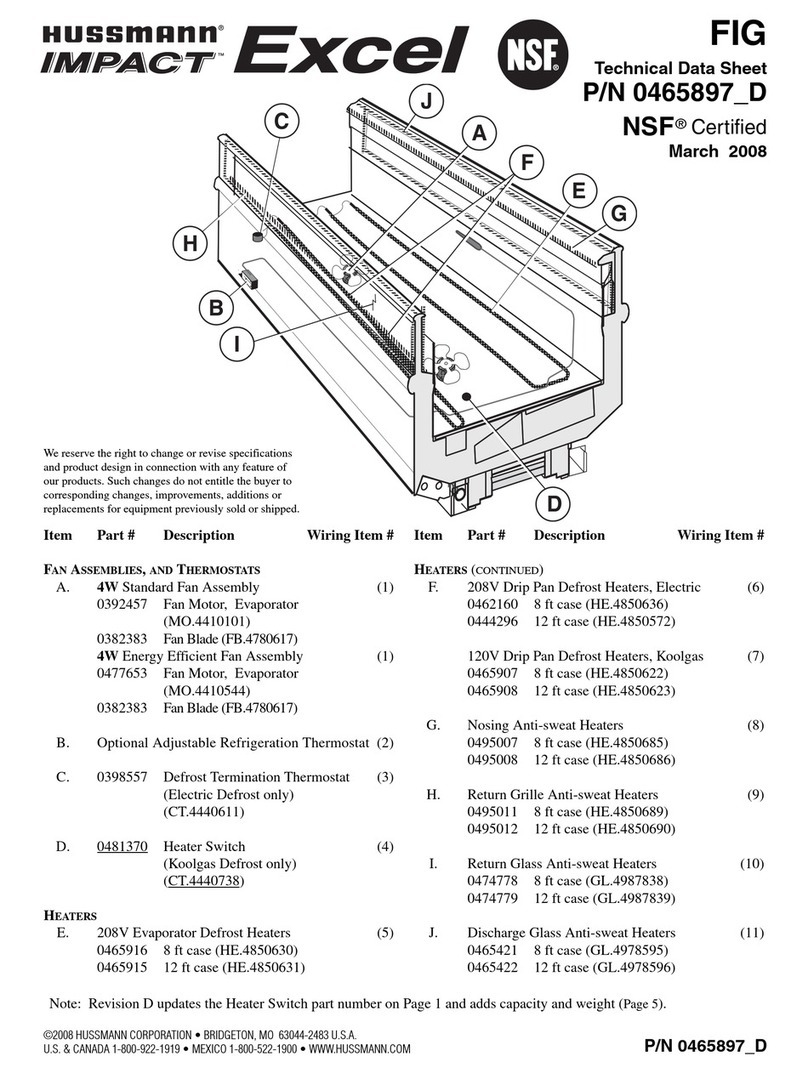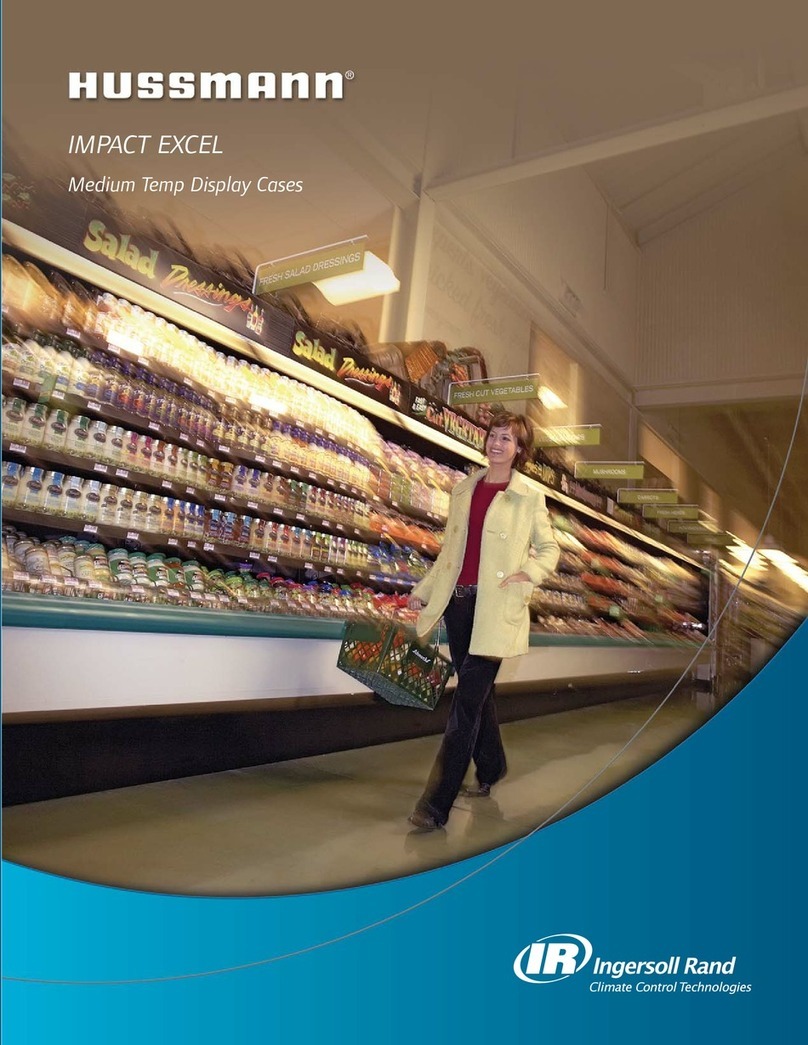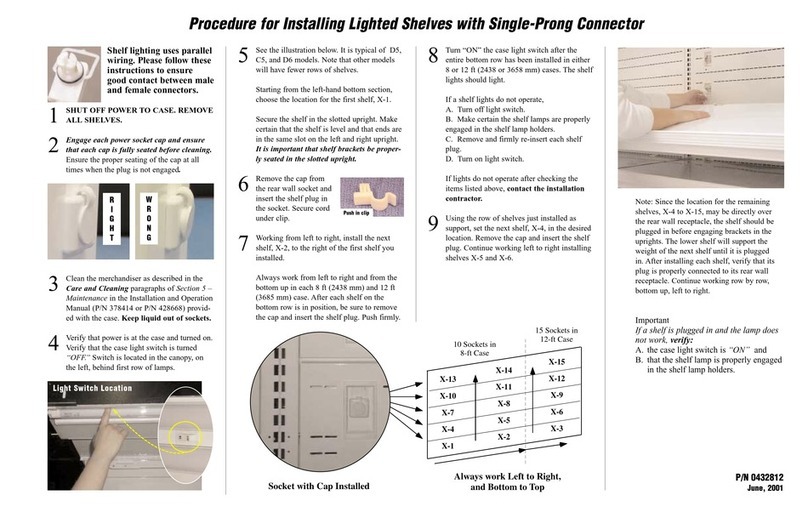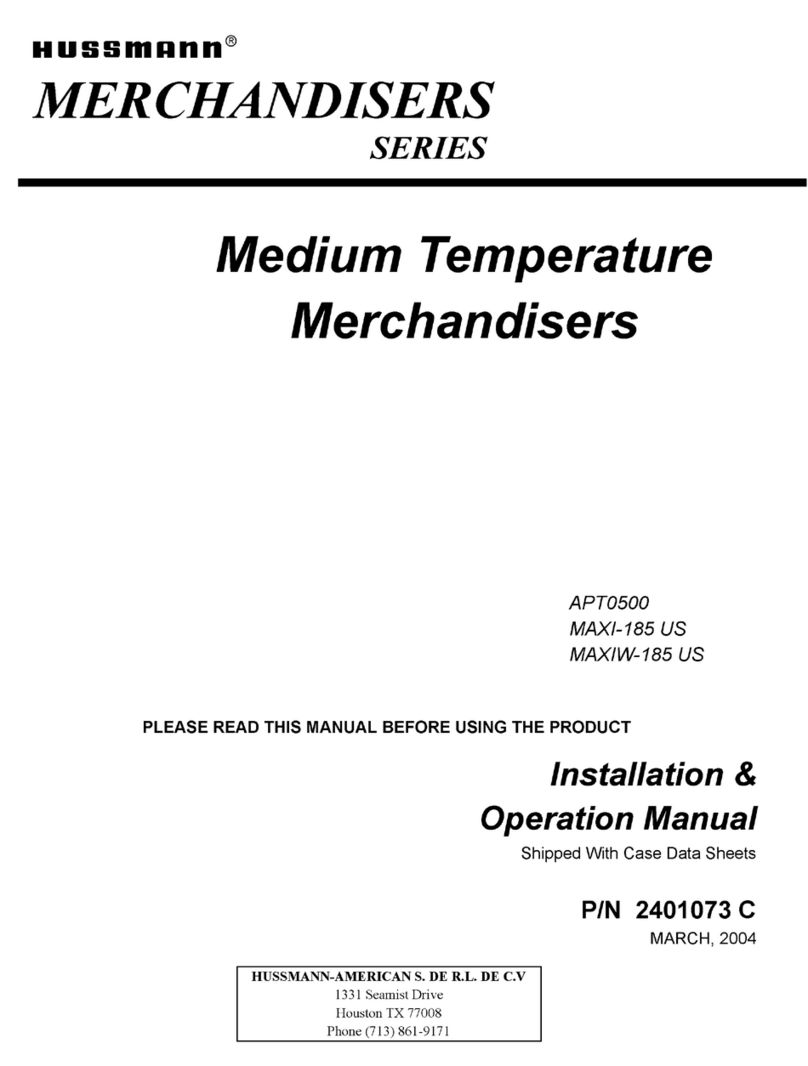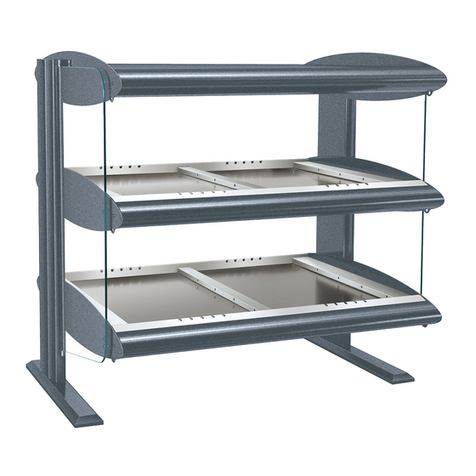Premium levella PRF36DX User manual

Model/Modelo:
PRF36DX/PRF37DX
SINGLE DOOR MERCHANDISER
REFRIGERATOR
VITRINA REFRIGERADOR
COMERCIAL DE UNA PUERTA 此行不印刷,A5大小,双胶纸80g,黑白印刷oduct is for domestic use only

2
The ambient temperature and humidity conditions
of the cooler climate class following the tab below:
•
Test room
climate class
Dry bulb
temperature (⁰C)
Relative Humidity
(%) Dew point(⁰C)
Water vapor massin
dry air (g/kg)
0
20
50
9.3
7.3
1
16
80
12.6
9.1
8
23.9
55
14.3
10.2
2
22
65
15.2
10.8
3
25
60
16.7
12.0
4
30
55
20.0
14.8
6
27
75
21.1
15.8
5
40
40
23.9
18.8
7
35
75
30.0
27.3
NOTE:
p
erformance and the energy consumption of the coolers. Therefore, the order of the
cl
imate class in the table is based on the water vapor mass column.
The maximum loading of big shelf is 16kg/35.3lbs.
The maximum loading of small shelf is 12kg/26.5lbs.
•
the appliance isto be installed in accordance with the
Safety Standard for RefrigerationSystems,
ANSI/ASHRAE 15.
•
the appliance needs repair, must use the same model
components.
•◆WARNING
Do not use means to accelerate the defrosting process
or to clean, other than those recommended by the
manufacturer.
The appliance shall be stored in a room without
continuously operating ignition sources(for example:
operating electric heater.
Do not pierce or burn.
Be aware that refrigerants may not contain an odour.
◆Warning: The appliance shall be stored in a
well-ventilated area where the room size corresponds
Warning: The appliance shall be stored so as to
prevent mechanical damage from occurring.
◆Check that cabling will not be subject to wear,
corrosion, excessive pressure, vibration, sharp edges,
or any other adverse environmental effects. The check
shall also take into account the effects of aging or
continual vibration from sources such as compressors
or fans.
◆Before carrying out Decommissioning procedure, it
is essential that the technician is completely familiar
with the equipment and all its detail. It is
recommended good practice that all refrigerants are
recovered safely. Prior to the task being carried out,
an oil and refrigerant sample shall be taken in case
analysis is required prior to re-use of recovered
refrigerant. It is essential that electrical power is
available before the task is commenced.
◆Warning: Risk of re / ammable materials, taking
care to avoid causing a e by igniting
ammable material.
Refrigerant class A3 per ANSI/ASHRAE 34
All maintenance staff and others working in the
local area shall be instructed on the nature of work
avoided.
If any hot work is to be conducted on the refrigerating
extinguishing equipment shall be available on hand.
adjacent to the charging area.
Notice: Any person who is involved with working on
or breaking into a
refrigerant circuit should hold a current valid
authority, which authorizes their competence to
handle refrigerants safely in accordance with an
Notice: Servicing shall only be performed as
recommended by the equipment manufacturer.
Maintenance and repair requiring the assistance of
other skilled personnel shall be carried out under the
supervision of the person competent in the use of
No person carrying out work in rel ation to a
REFRIGERATING SYSTEM which involves exposing
any pipe work shall use any sources of ignition in
explosion. AIl possible ignition sources, incl luding
away from the site of installation, repairing,
removing and disposal,during which refrigerant
can possibly be rel leased to the surrounding space.
Prior to work taking pl ace, the area around the
equipment shall be surveyed to make sure that there
Smoking" signs shall be displ layed.
This equipment is intended for the storage and
display of non-time / temperature control for safety
foods bottled or canned products only.
••

3
Checking for presence of refrigerant, The area shall
be checked with an appropriate refrigerant detector
prior to and during work, to ensure the technician
is aware of potentially toxic or lammable
atmospheres. Ensure that the leak detection
equipment being used is suitable for use with all
applicable refrigerants, i.e., nonsparking,
adequately sealed, or intrinsically safe.
Ensure that the area is in the open or that it is
adequately ventilated before breaking into the
system or conducting any hot work. A degree of
ventil lation shall continue during the period that the
work is carried out. The ventilation should safely
disperse any rel leased refrigerant and preferably
expel it externally into the atmosphere.
Detection of ammable refrigerants: Under no
circumstances shall potential sources of ignition be
used in the searching for or detection of refrigerant
leaks. A halide torch (or any other detector using a
naked ame) shall not be used.
b) that no live electrical components and wiring are
exposed while charging,recovering or purging the
system;
c) that there is continuity of earth bonding.
SERVICING
The following checks shall be applied to installations
using FLAMMABLE REFRIGERANTS:
a) the actual REFRIGERANT CHARGE is in accordance
with the room size within which the refrigerant
containing parts are installed;
b) the ventilation machinery and outlets are operating
adequately and are not obstructed;
c) if an indirect refrigerating circuit is being used, the
secondary circuit shall be checked for the presence of
refrigerant;
d) marking to the equipment continues to be visible
and legible. Markings and signs that are illegible shall
be corrected;
e) refrigerating pipe or components are installed in a
position where they are unlikely to be exposed to any
substance which may corrode refrigerant containing
components, unless the components are constructed of
materials which are inherently resistant to being
corroded or are suitably protected against being so
corroded.
Initial safety checks shall include:
a) that capacitors are discharged: this shall be done in
a safe manner to avoid possibility of sparking;
REPAIRS COMPONENTS
During repairs to sealed components, all electrical
supplies shall be disconnected from the equipment
being worked upon prior to any removal of sealed
covers, etc. If it is absolutely necessary to have an
electrical supply to equipment during servicing, then
a permanently operating form of leak detection shall
be located at the most critical point to warn of a
potentially hazardous situation.
Particular attention shall be paid to the following to
ensure that by working on electrical components,
the casing is not altered in such a way that the level
of protection is affected. This shall include damage
to cables, excessive number of connections,
terminals not made to original specication, damage
to seals, incorrect tting of glands, etc.
Ensure that the apparatus is mounted securely.
Ensure that seals or sealing materials have not
degraded to the point that they no longer serve the
purpose of preventing the ingress of ammable
atmospheres. Replacement parts shall be in
accordance with the manufacturer’s specications.
Do not apply any permanent inductive or capacitance
loads to the circuit without ensuring that this will not
exceed the permissible voltage and current permitted
for the equipment in use.
Intrinsically safe components are the only types that
can be worked on while live in the presence of a
ammable atmosphere. The test apparatus shall be
at the correct rating.
Replace components only with parts specied by the
manufacturer. Other parts can result in the ignition
of refrigerant in the atmosphere from a leak.
Replace components only with parts specied by the
manufacturer. Other parts can result in the ignition
of refrigerant in the atmosphere from a leak.
LABELLING
Equipment shall be labelled stating that it has been
de-commissioned and emptied of refrigerant. The
label shall be dated and signed. For appliances
containing FLAMMABLE REFRIGERANTS, ensure that
there are labels on the equipment stating the
equipment contains FLAMMABLE REFRIGERANT.

4
SAFETY REQUIREMENTS
DANGER: Risk of fire or explosion. Flammable
refrigerant used. Do not puncture refrigerant tubing.
•Do not use mechanical devices to defrost
refrigerator.
•Ensure that servicing is done by factory
authorized service personnel, to minimize
product damage or safety issues.
•Consult repair manual or owner’s guide before
attempting to service this product. All safety
precautions must be followed.
•Dispose of properly in accordance with federal
or local regulations.
•Follow handling instructions carefully.
WARNING: Keep ventilation openings, in the
appliance enclosure or in the built-in structure, clear
of obstruction.
WARNING: Do not use mechanical devices or other
means to accelerate the defrosting process, other
than those recommended by the manufacturer.
WARNING: Do not damage the refrigerant circuit.
WARNING: Do not use electrical appliances inside
the food storage compartments of the appliance,
unless they are of the type recommended by the
manufacturer.
CAUTION: Children should be supervised to ensure
that they do not play with the appliance.
DANGER: Risk of child entrapment. Before throwing
away an old appliance:
•Remove the door or lid.
•Leave shelves in place so that children may not
easily climb inside.
This appliance is intended to be used in household
and similar applications such as:
•Staff kitchen areas in shops, offices and other
working environments;
•Farmhouses and by clients in hotels, motels and
other residential type environments;
•Bed and breakfast type environments;
•Catering and similar non-retail applications.
SAFETY REQUIREMENTS
This appliance is not intended for use by persons
(including children) whose physical, sensory, or
mental capabilities may be different or reduced,
or who lack experience or knowledge, unless such
persons receive supervision or training to operate
the appliance by a person responsible for their
safety.
Do not store explosive substances such as aerosol
cans with flammable propellant in this appliance.
GROUNDING INSTRUCTIONS
This appliance must be grounded. Grounding
reduces the risk of electrical shock by providing an
escape wire for the electrical current.
This appliance has a cord that has a grounding
wire with a 3-prong plug. The power cord must be
plugged into an outlet that is properly grounded.
If the outlet is a 2-prong wall outlet, it must be
replaced with a properly grounded 3-prong wall
outlet. The serial rating plate indicates the voltage
and frequency the appliance is designed for.
WARNING - Improper use of the grounding
plug can result in a risk of electric shock.
Consult a qualified electrician or service agent
if the grounding instructions are not completely
understood, or if doubt exists as to whether the
appliance is properly grounded.
Do not connect your appliance to extension
cords or together with another appliance in the
same wall outlet. Do not splice the power cord.
Do not under any circumstances cut or remove the
third ground prong from the power cord. Do not
use extension cords or ungrounded (two prongs)
adapters.
If the power supply cord is damaged, it must be
replaced by the manufacturer, its service agent or
similarly qualified person in order to avoid hazard.
Important Safety Information
READ AND FOLLOW ALL SAFETY INSTRUCTIONS
SAVE THESE INSTRUCTIONS!

5
INSTALLATION INSTRUCTIONS
LOCATION
•Two people should be used when moving the
appliance.
•Remove interior and exterior packaging prior to
installation. Wipe the outside of the appliance
with a soft, dry cloth and the inside with a
lukewarm wet cloth.
•Place the appliance on a floor that is strong
enough to support it when it is fully loaded.
•Do not place the appliance in direct sunlight or
near sources of heat, such as a stove or heater,
as this can increase electrical consumption.
Extreme cold ambient temperatures may also
cause the appliance to perform improperly.
•Do not use the appliance near water, for
example in a wet basement or near a sink.
•This appliance is intended for household use
only. It is not designed for outside installation,
including anywhere that is not temperature
controlled (garages, porches, vehicles, etc.).
•Before connecting the appliance to a power
source, let it stand upright for approximately
6 hours. This will reduce the possibility of a
malfunction in the cooling system from being
handled during transportation.
•This appliance is 44.5 cm (17.5 inches) wide by
83.3 cm (32.8 inches) high by 48.1 cm (18.9
inches) deep.
•Allow 12.7 cm (5 inches) of space between the
back, sides and top of the appliance and all
adjacent walls.
•This appliance is intended for free-standing
installation only and is not intended to be
built into a cabinet or counter. Building in this
appliance can cause it to malfunction.
OPERATING INSTRUCTIONS
FEATURES
1. Control Panel: For controlling the temperature
inside the appliance; the compressor activates as
soon as the temperature rises above the desired
level.
2. Tempered Glass Door: Tinted for UV protection
while still allowing for easy interior viewing.
3. Magnetic Door Gaskets: Tight fitting seals retain
all the cooling power and humidity levels.
4. Plastic Coated Shelves: Odor resistant,
rustproof, and removable for easy cleaning.
5. Leveling Leg: Adjust to level the appliance.
1
2
34
5
This manual suits for next models
1
Table of contents
Languages:
Popular Merchandiser manuals by other brands

Structural Concepts
Structural Concepts Oasis Mobile Series Installation & operating manual
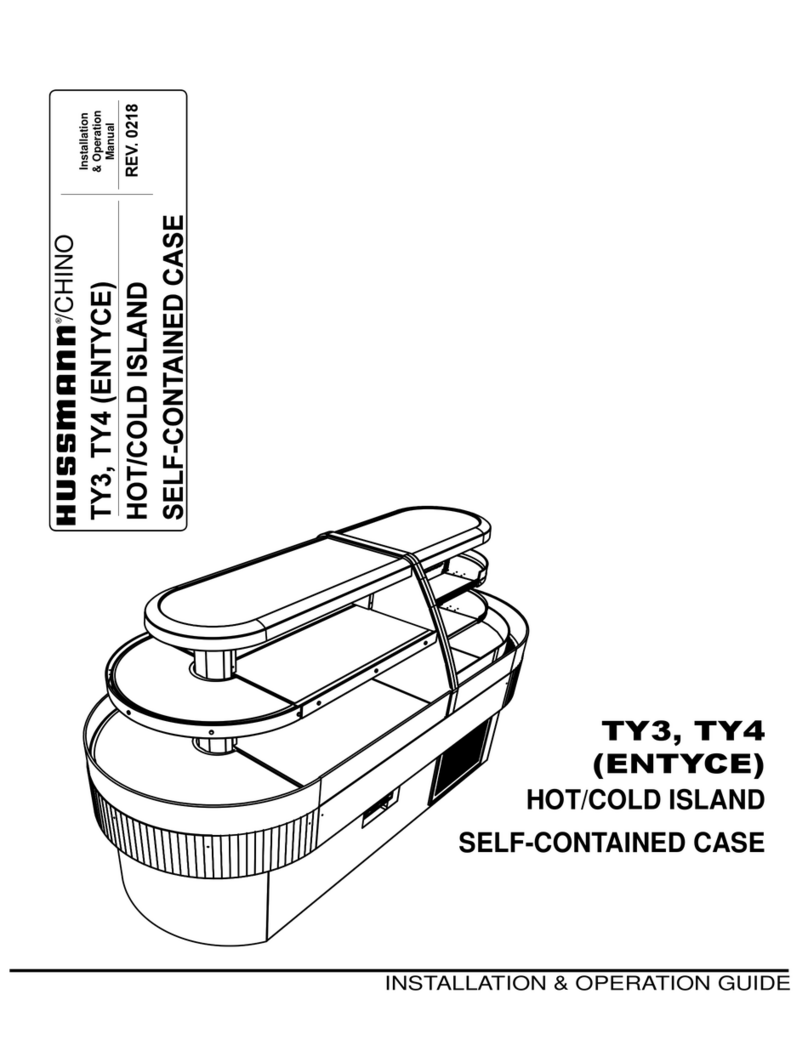
Hussmann
Hussmann ENTYCE TY3 Installation & operation manual

Haussmann
Haussmann RL Installation & operation manual
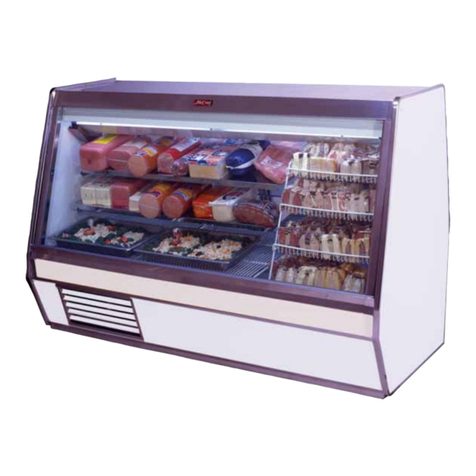
Howard McCray
Howard McCray R-CDS32E-4 Specifications
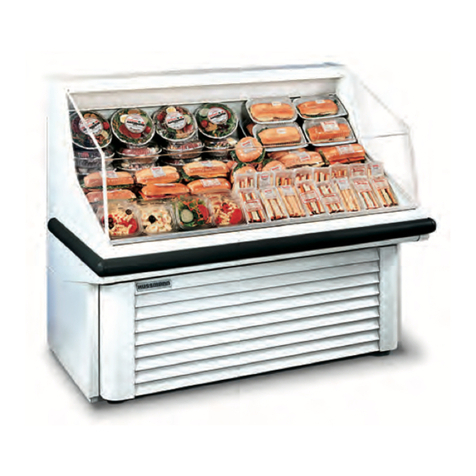
Hussmann
Hussmann microSC SHM-A Series Installation & operation manual

EPTA
EPTA iarp Cool Emotions Delight Lite User instructions
